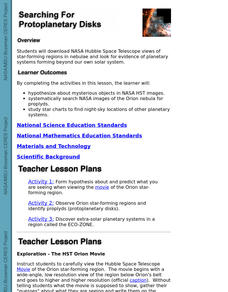Curated Video
Science of the James Webb Telescope Explained!
You’ve probably heard about the James Webb Space Telescope and seen some cool pictures. But why should astronomers have all the fun? How do we get to use this new toy ourselves?
Curated Video
NASA's First Chief Astronomer, the Mother of Hubble
In a time when women were discouraged from studying math and science, Nancy Grace Roman became a research astronomer and the first Chief of Astronomy at NASA. Known today as the "Mother of Hubble," she was instrumental in taking the...
Curated Video
NASA Names Upcoming Telescope to Honor the 'Mother of Hubble'
In a time when women were discouraged from studying math and science, Nancy Grace Roman became a research astronomer and the first chief of astronomy at NASA. Known today as the “Mother of Hubble,” she was instrumental in taking the...
Curated Video
Mission Possible: Women of the Hubble Space Telescope
When they were growing up, six women couldn’t have imagined that their lives would take them on a journey to NASA to work with the Hubble Space Telescope. From astronaut to social media lead, from scientists to engineers, these featured...
Curated Video
Meet the Women of NASA's Hubble Space Telescope
Celebrate #InternationalWomensDay and learn more about the women behind NASA's Hubble Space Telescope. Paul Morris (KBRwyle): Lead Producer Aaron E. Lepsch (ADNET): Technical Support “A Bright Future” by Andrew Benjamin DeWitt [ASCAP]...
TMW Media
The Very Large Array Telescope: VLA's configurations for seeing in space
Explain the process of transporting an antenna. Why are the antenna moved into different configurations? What discoveries did the scientists find recently? What do you need to know in order to work in this field? The Very Large Array...
World Science Festival
Cool Jobs: Astronaut & Hubble Doctor
NASA astronaut Michael Massimino talks about the “right stuff” you need to work in space—a healthy helping of math and science, but also passion and patience. Listen to this fascinating astronaut's journey to save the Hubble Space...
Zach Star
What You Should Know About Getting a Career In Astronomy Astrophysics
This video will cover how to get into space research (such as astrophysics or astronomy) and some research that is going on. For those looking into space related majors, your best options are astronomy and astrophysics. However, as an...
Curated Video
The Real Science of the EHT Black Hole
So, how do you take a picture of a black hole? The beast in question is the supermassive black hole in the center of this – the M87 elliptical galaxy. It has an estimated mass of several billion times that of the Sun, which gives it an...
Curated Video
Did Time Start at the Big Bang?
Our universe started with the big bang. But only for the right definition of “our universe”. And of “started” for that matter. In fact, probably the Big Bang is nothing like what you were taught. A hundred years ago we discovered the...
World Science Festival
Cool Jobs: NASA astronaut Michael Massimino
NASA astronaut Michael Massimino talks about the “right stuff” you need to work in space—a healthy helping of math and science, but also passion and patience. Working in space requires incredible precision: Astronauts have to practice...
World Science Festival
Spotlight: Things That Are Really There
Strip away the trimmings of a traditional science presentation, add cocktails, and you have WSF Spotlight. Here, astrophysicist Mario Livio, from the Hubble Space Telescope Science Institute, takes us on a tour of the cosmos in all its...
Curated OER
I've Got Your Number
Students assess the journalistic value of numbers used in newspaper articles while learning about the significance of the Hubble telescope's new data on the age of the universe.
Curated OER
Worksheet 19: Ship Positions
In this math worksheet, students read informational paragraphs and then answer 18 questions using data from their readings. Questions are about vectors, positions, distance and orbits.
Curated OER
Algebra: Mirror, Mirror on the Universe
Learners assess how algebra, telescopes, space exploration and optics are so important in astronomy. They encounter studies on the Hubble Space Telescope, Hubble Deep Field and how algebra helps to determine the effects of contamination...
Curated OER
A Distant View
Students investigate the essential concepts of how lenses work to magnify vision, and then build simple telescopes to demonstrate their understanding. They write a description of how their telescope could be improved and how it works.
Curated OER
Stellar Observations
Ninth graders study the uses of spectroscopy and the operation of the Hubble space telescope. In this astronomy lesson students complete a lab activity that includes graphing star color and temperature.
Curated OER
Searching For Protoplanetary Disks
Students download NASA Hubble Space Telescope views of star-forming regions in nebulae and look for evidence of planetary systems forming beyond our own solar system. They hypothesize about mysterious objects in NASA HST images.
Curated OER
How Many Stars in the Milky Way?
Students perform an experiment in which they will use a statistical method called `sampling' to count to a billion (and beyond). Students practice sampling by estimating the number of characters on a page from the classified section of a...
Curated OER
Sketching Cylinders
Students create nets of cylinders. In this geometry lesson, students calculate the surface area of cylinders and other solids. They show their understanding of three-dimensional shapes by solving problems.













